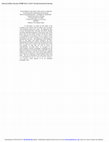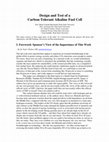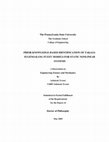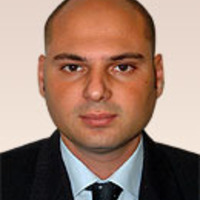Papers by Mirna Urquidi-Macdonald
Journal of The Electrochemical Society, 1990
ECS Meeting Abstracts, 2008
ECS Meeting Abstracts, 2007
not Available.

The PDM [Point Defect Model, D. D. Macdonald, Pure Appl. Chem., 71, 951 (1999)] describes the cor... more The PDM [Point Defect Model, D. D. Macdonald, Pure Appl. Chem., 71, 951 (1999)] describes the corrosion of passive metals in aqueous media in terms of the generation and annihilation of point defects at the passive film interfaces. In the current work, we have modified the PDM to provide a comprehensive, atomic scale description of the growth of bilayer passive films on zirconium to simulate the corrosion of Zircaloy fuel cladding in BWRs and PWRs under high burn-up conditions. Two models have been formulated; one comprising a hydride inner (barrier) layer and an oxide outer layer and other comprising an oxide inner layer and an oxide outer layer for PWR and BWR cladding, respectively. Since there are currently no experimental data for the kinetics of defect generation and annihilation at the passive film interfaces for Zircaloys under PWR/BWR conditions, of the type that are required for this analysis, this paper focuses only on exploring and predicting trends in the corrosion beha...
ECS Meeting Abstracts, 2011
not Available.

A predictive and self-consistent mathematical model has been developed to describe the localized ... more A predictive and self-consistent mathematical model has been developed to describe the localized corrosion in steam generators. The model recognizes that the internal and external environment are coupled by the need to conserve charge in the system. Thus, solution of Laplace`s equation for the external environment (outside the crevice) provides the boundary condition for the electric potential at the crevice mouth, which is needed for solving the system of mass transfer equations for the internal environment (inside the crevice). Mass transfer by diffusion, ion migration, and convection was considered. Heat and momentum transfer equations are solved simultaneously, with the mass balance equation for each species and the condition of electroneutrality inside the cavity being considered. The model takes into account the porosity and tortuosity in the corrosion product deposit in the crevice. The homogeneous chemical reactions (hydrolysis of the products of the anodic reaction and the autoprotolysis of water) are included in the model. The model, in this preliminary form predicts the solution chemistry, potential drop, and temperature distribution inside the crevice. An order of magnitude estimate of the crevice corrosion rate also obtained. At this point, the model predicts only the steady state solution, but it is recognized thatmore » a steady state may not exist under normal conditions.« less

ECS Transactions, 2013
In this paper, we report an EIS study of the evolution of the passive state of carbon steel in co... more In this paper, we report an EIS study of the evolution of the passive state of carbon steel in contact with simulated concrete pore water. By mining the impedance data, we have determined that, with time, the defect structure and the defect-dependent properties of the barrier layer of the passive film on iron remain invariant, but that the change in the properties of the passive film, as a whole, can be accounted for in terms of changes in the thickness of the precipitated outer layer. The importance of this finding is that we may apply, with added confidence, the time-independent Point Defect model for describing the barrier layer on carbon steel in contact with concrete pore water over periods of time that are well in excess of experimentally accessible times. Thus, as envisaged in the super-container concept in Belgium’s technology for the disposal of High Level Nuclear Waste (HLNW), the carbon steel over-pack will be exposed to concrete pore water for times exceeding 100,000 yea...
Journal of Power Sources, 2008
This article appeared in a journal published by Elsevier. The attached copy is furnished to the a... more This article appeared in a journal published by Elsevier. The attached copy is furnished to the author for internal non-commercial research and education use, including for instruction at the authors institution and sharing with colleagues. Other uses, including reproduction and distribution, or selling or licensing copies, or posting to personal, institutional or third party websites are prohibited. In most cases authors are permitted to post their version of the article (e.g. in Word or Tex form) to their personal website or institutional repository. Authors requiring further information regarding Elsevier's archiving and manuscript policies are encouraged to visit: http://www.elsevier.com/copyright
Journal of The Electrochemical Society, 1990
ABSTRACT
Journal of The Electrochemical Society, 1986
Algorithms have been developed to apply the Kramers‐Kronig transforms in the analysis of experime... more Algorithms have been developed to apply the Kramers‐Kronig transforms in the analysis of experimental electrochemicalimpedance data. The application of these algorithms is illustrated by transforming calculated impedance datafor an electrical equivalent circuit, by transforming ...
Journal of The Electrochemical Society, 1990
A theory is developed for the steady‐state properties of passive films that form on metals and al... more A theory is developed for the steady‐state properties of passive films that form on metals and alloys in aqueous environments.This theory is based on the point defect model developed earlier, and predicts that the steady‐state thickness ofthe barrier film and the log of the ...

Electrochimica Acta, 2002
The compatibility of polyphosphazene (PPZ) polymer electrolytes with MnO2/C/SPE intercalation cat... more The compatibility of polyphosphazene (PPZ) polymer electrolytes with MnO2/C/SPE intercalation cathodes (IC) was investigated. Three-layered laminates of a phosphazene-based solid polymer electrolyte (SPE) film sandwiched between two MnO2-based ICs (one preloaded with lithium) were constructed. The cathodes were fabricated by either solvent casting or compression techniques. Two different crystal forms of manganese(IV) oxide—λ-MnO2 and γ-MnO2—were employed, together with methoxy ethoxy ethoxy PPZ (MEEP) SPE binder material. Carbon black was employed as the electronically conductive phase. One cathode in each laminate was prepared in the ‘chemically intercalated’ form by using LiMn2O4 in place of MnO2. The podand polymer, SMEP, which has better thin film mechanical properties than does MEEP, was complexed with lithium trifluoromethane sulfonate (Li triflate) and used as the SPE. Li+ ions were cycled galvanostatically between the two-ICs, through the phosphazene-based SPE layer. The performance of the cell was continuously monitored by electrochemical impedance spectroscopy (EIS) and by measuring the laminate thickness and voltage drop. The method of cathode fabrication (casting vs. pressing) was found to be the primary factor influencing the cycle life.

arXiv: Chemical Physics, 2005
This paper presents new results which may constitute a breakthrough in the effort to develop fuel... more This paper presents new results which may constitute a breakthrough in the effort to develop fuel cells truly suitable for use in cars and trucks. For decades, researchers have known that the alkaline fuel cell (AFC) is much cheaper to make, more efficient and more durable than the more popular PEM fuel cell; however, "carbon poisoning" (either from CO2 in air or from contaminants in reformed methanol) causes big problems in the kind of oxygen-hydrogen AFC commonly used in space. This paper reports successful tests of a technique for coating the electrodes with polystyrene which, in conjunction with older common-sense techniques, appears to solve the problem. This kind of design is applicable to cars run on hydrogen fuel, on reformed methanol or even direct methanol. Developing a test methodology was a major part of the work. A foreword by one of the sponsors at NSF discusses the larger importance of this work for energy security and the environment.

In this thesis, a type of neuro-fuzzy models called Takagi-Sugeno-Kang (TSK) models are studied a... more In this thesis, a type of neuro-fuzzy models called Takagi-Sugeno-Kang (TSK) models are studied as a tool for static nonlinear system modeling. An error measure is defined using the training dataset and subsequently minimized with respect to the unknown model parameters. Therefore, the parameter estimation is merely an nonlinear optimization problem. In this thesis, the focus is only on the parameters estimation of TSK models under the assumption that their structure has been fixed a priori. In order to have consistent and near optimal parameter estimates, a sufficiently large noise-free training dataset is required. However, if we have more parameters than what can be correctly estimated from a training dataset then the performance of the trained model becomes questionable. The input-output datasets generated by majority of real world systems usually have low signal to noise ratio, which further reduces their estimation capability. Hence, it becomes imperative to devise robust para...

Journal of Nuclear Materials, 2008
Spent, unreproccessed nuclear fuel is generally contained within the operational fuel sheathing f... more Spent, unreproccessed nuclear fuel is generally contained within the operational fuel sheathing fabricated from a zirconium alloy (Zircaloy 2, Zircaloy 4, or Zirlo) and is then stored in a swimming pool and/or dry storage facilities until permanent disposal in a licensed repository. During this period, which begins with irradiation of the fuel in the reactor during operation, the fuel sheathing is exposed to various, aggressive environments. The objective of the present study was to characterize the nature of the passive film that forms on pure zirconium in contact with an aqueous phase [0.1 M B(OH)3 + 0.001 M LiOH, pH 6.94] at elevated temperatures (in this case, 250 °C), prior to storage, using electrochemical impedance spectroscopy (EIS) with the data being interpreted in terms of the point defect model (PDM). The results show that the corrosion resistance of zirconium in high temperature, de-aerated aqueous solutions is dominated by the outer layer. The extracted model parameter...
Performance of single-cell Li-air batteries with three different air cathodes, Energy Research Co... more Performance of single-cell Li-air batteries with three different air cathodes, Energy Research Corporation (ERC), E-TEK, and Alupower are reported. Li/8M KOH/ERC air cathode/air cells under a constant 100 ohm load gave average values for a cell potential, current density, power density, and the rate of Li weight loss of 2.71 V, 0.029 A/cm 2 , 0.079 W/cm 2 , and 0.078 gm/hr/cm 2 , respectively. Current-voltage characteristics are also presented for an Alupower Pt10 air cathode in 12M KOH with both air and seawater on the backside. This cathode produced open circuit potential values of-0. 2 V SCE (air) and -1.19 V SCE (seawater).
50°C, showing the total current (iT) and both anodic (iA) and cathodic (iH) partial currents as a... more 50°C, showing the total current (iT) and both anodic (iA) and cathodic (iH) partial currents as a function of cycle number vii











Uploads
Papers by Mirna Urquidi-Macdonald